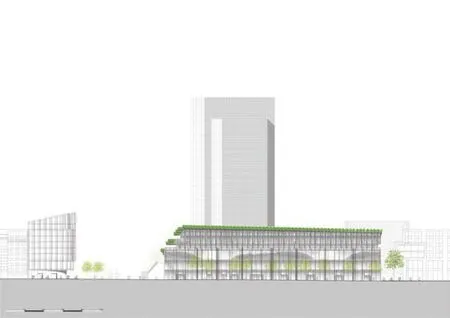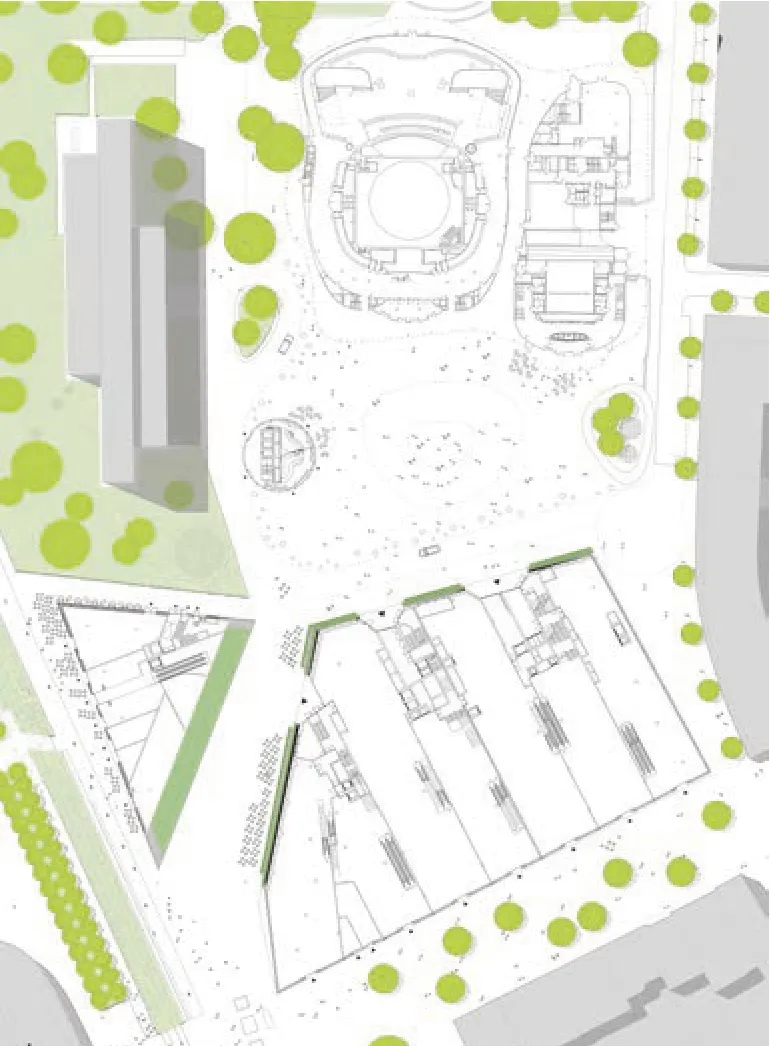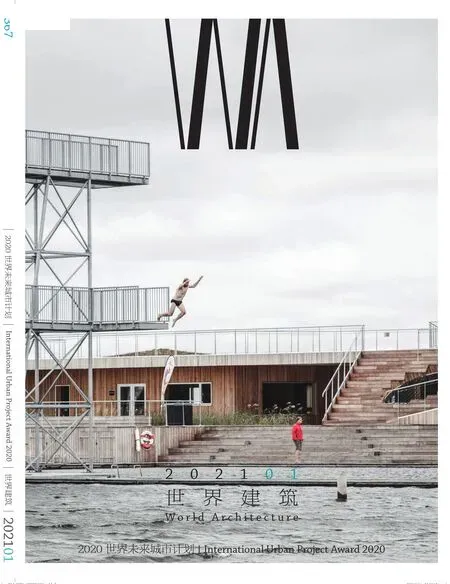科伯格2号商业综合体,杜塞尔多夫,德国
建筑设计:英根霍芬建筑事务所

1 德雷施本大厦、米利佩德和霍夫加藤,1964年/Dreischeibenhaus, Tausendfüßler, Hofgarten, 1964(图片来源/Sources: city archive Düsseldorf)
城市与公园之间——一种新型的建筑
为回应城市现状,科伯格2号分为商业和办公两部分。梯形主体高5层,其倾斜的外立面朝向彼此,与稍小些的三角形体量遥相对应,形成了通向古斯塔夫-格林德根斯广场的动态入口。沿着影子商业街或柏林大道向这里走来,你会看到战后现代主义的标志性建筑——德雷施本大厦和杜塞尔多夫城市剧院——及位于其后侧、种满了玉兰树的霍夫加藤公共花园。正对着古斯塔夫-格林德根斯广场的科伯格2号,通体覆盖着绿植,与霍夫加藤公共花园相对话。
从功能性来看,科伯格2号将文化及购物这种城市生活中不同的层面衔接起来,集零售、餐饮、办公和娱乐于一体,总建筑面积达42,000m2。紧临影子商业街——德国最繁忙的购物街之一——的玻璃立面高27m、长120m。多孔金属网骨架作为内部结构,从封闭到开敞,不同视角呈现出的空间透明度各不相同。包含屋顶在内的其他外立面则相对柔和,其上种植了长达8km的角木树篱——这也是全欧洲最大的绿植立面。对侧空间高10m,与道路相衔接的倾斜屋面也通体覆盖着绿植,有助于让来访者放松身心。绿植区块的构图灵感来自于大地艺术,谨慎地调和了城市和公园之间的不确定感。
长达8km的角木树篱
事务所选用了当地一种阔叶植物——角木,该品种在冬季不掉叶子。春季,树篱上满是鲜嫩的浅绿色叶片,夏季变为浓郁的深绿色,秋季则变为金黄。这些绿植改善了城市小微气候——在夏季抵御阳光辐射,降低城市高温,凝结CO2,储存水分,吸收噪音且有助于激发生物多样性。角木树篱产生的生态效应约等同于80棵成熟的落叶植物。数十年来,英根霍芬建筑事务所走访了不同的气候区域,致力于打造尽可能多的绿地以回馈城市。依托于“超级绿色”理念,事务所正全面实行可持续发展策略。这种根据当地情况为每个项目制定适宜种植计划的理念,标志着城市应对气候变化的前瞻性思考。
本项目中,事务所与柏林博伊特应用科技大学的植物学家施特劳奇博士联合制定了详细的植物技术计划,并在实验装置上进行了测试。基于对场地的精确分析,明确了建筑需求,例如高1.3m的树篱所需种植机的尺寸与型号。此外,还制定了一个提供水、营养物质并对植株进行定期修剪的维护计划。科伯格2号屋面上的灌木丛生长在常规植物床基上,北立面和西立面的灌木丛则生长在一种水平设置的容器中,该特殊培育系统分布在与立面紧密相连的独立支撑结构上。苗圃自2016年起就在培育植株,2019年秋季,根系发育完全的植株被运送到了施工现场。
自1992年起推动城市发展
克里斯托弗·英根霍芬自1992年起就有了重新设计杜塞尔多夫市中心的想法。通过调研、深化城市规划理念和具体实践,在长期以机动车及畅通无阻的交通为导向的城市演进过程中,他起到了不可或缺的作用。例如,在2003年的MIPIM会议上,他提出了在国王大道、扬·韦勒姆广场、霍夫加滕公园和古斯塔夫-格林德根斯广场的附近区域进行系统再发展的设计倡议,倡议包括借由隧道缓解交通压力及拆除高架公路。2014年英根霍芬建筑事务所在科伯格2号的国际竞赛中胜出。2018-2020年,事务所对杜塞尔多夫剧院进行了翻修,同时,运用谨慎且低调的设计策略对古斯塔夫-格林德根斯广场周边的建筑进行了彻底的内部整修。
在这个立体交通高速路一直占据主导之地,秉承着庭院建筑师海因里希·希勒布雷希特的精神,依托于以更多市民为本的城市规划策略,霍夫加藤公共花园在2013年重返城市中心。在杜塞尔多夫的新市中心,3个处于不同的位置的建筑汇聚形成了城市肌理:简洁冷峻的德雷施本大厦(赫尔穆特·亨特里奇和休伯特·派特克宁格设计,1960年),颜色明快、形态轻盈的城市剧院(波恩哈德·普福设计,1970年),以及通体绿色、具有动态立面的科伯格2号(英根霍芬建筑事务所设计,2020年)。每个建筑都代表着其所处的时代,互不争抢,各自伫立。(天妮 译)
Between City and Park – A New Type of Building
Kö-Bogen II, a two-part commercial and office building, was developed in response to the existing urban situation. With their sloping façades turned towards each other, the five-storey,trapezoidal main building, together with its smaller,triangular counterpart, form a dynamic entrance to Gustaf-Gründgens-Platz. Approaching the building from Schadowstrasse or Berliner Allee gives an unobstructed view of the icons of postwar modernism - the Dreischeibenhaus and the Schauspielhaus - and behind them the Hofgarten[the public garden] with its magnolia trees. The Kö-Bogen façades facing the plaza at Gustaf-Gründgens-Platz are entirely green, entering into a dialogue with the Hofgarten.
Functionally, Kö-Bogen II mediates between the different facets of urban life: between the pleasures of culture and of shopping. A variety of uses - retail,gastronomy, offices, and recreation - come together on a gross floor area of 42,000 square metres.Measuring 27 metres high and 120 metres long, the façade of the main building along Schadowstrasse -one of the busiest shopping streets in Germany - is completely glazed. Expanded metal slats structure the interior, varying in transparency from closed to open, depending on the perspective. The other façades including the roof are more tempered and planted with 8 kilometres of hornbeam hedges -Europe's largest green façade. The accessible sloping roof of the 10-metre-high building opposite is also completely green and invites visitors to relax and take in the sun. The composition of these green areas is inspired by Land Art, and enable Kö-Bogen II to oscillate in a deliberate indeterminacy between city and park.
Eight Kilometres of Hornbeam Hedges
The hornbeam was chosen as a native hardwood,and the selected varieties keep their leaves in winter. In spring the hedges glisten with their fresh, light green foliage, which deepen to rich, dark green in summer, then to golden brown in autumn.This greenery improves the city's microclimate -it protects against the sun's rays in summer and reduces urban heat, binds carbon dioxide, stores moisture, absorbs noise, and supports biodiversity.The ecological bene fit of the hornbeam hedges equals that of approximately 80 fully grown deciduous trees. Giving back as much green as possible to the city is a task that ingenhoven architects have been working on for decades and across different climate zones. With its supergreen concept the office is taking a comprehensive approach to sustainability.A bespoke planting concept is developed for each project according to the local context and marks a forward-thinking urban response to climate change.
For the project in Düsseldorf, a detailed phytotechnological plan was developed in collaboration with the botanist Prof. Dr. Strauch from Beuth University of Applied Sciences in Berlin,and tested in a trial installation. Based on a precise site analysis, structural requirements were de fined,such as the size and type of planters needed for the 1.3-metre-high hedges. A concept for the supply of water and nutrients along with plant maintenance,including regular pruning, was also developed.While the shrubs on the roof of Kö-Bogen II grow in conventional plant beds, those on the north- and west-facing façades are grown in a special system of horizontally arranged containers on a separate supporting structure that is firmly connected to the façade. The plants were supplied by a nursery where they had been growing since 2016, so they could be delivered to the construction site in autumn 2019with fully developed roots.

3 剖面/Sections

4 剖面/Sections
Impulses for Urban Development Since 1992
Christoph Ingenhoven has been pursuing the idea of redesigning the centre of Düsseldorf since 1992. With studies, urban planning concepts, and concrete projects, he has provided essential impulses for the evolution of a city that was long oriented towards cars and the unimpeded flow of traffic. In 2003 at the MIPIM, for example, he presented a design for comprehensive redevelopment in the area around Königsallee, Jan-Wellem-Platz, Hofgarten,and Gustaf-Gründgens-Platz, including the transfer of traffic into tunnels and the demolition of the elevated highway. In 2014, ingenhoven architects won the limited international competition for Kö-Bogen II. From 2018 to 2020, the office refurbished the Düsseldorfer Schauspielhaus. The approach was sensitive and understated, while undertaking a clear internal restructuring of the building towards Gustaf-Gründgens-Platz.
Today, at the site where an elevated motorway dominated the landscape until 2013 - in the spirit of the garden architect Heinrich Hillebrecht - the Hofgarten has moved back into the heart of the city through a more people-oriented approach to urban planning. In Düsseldorf's new city centre,three different architectural positions converge to shape the urban fabric: the clear austerity of the Dreischeibenhaus by Helmut Hentrich and Hubert Petschnigg [1960], the buoyant lightness of the Schauspielhaus by Bernhard Pfau [1970],and the entirely green, dynamic façades of Kö-Bogen II by ingenhoven architects [2020]. Each representative of its time, none in competition with the others.
项目信息/Credits and Data
功能/Programme: 零售,餐饮,办公,地下停车/Retail,gastronomy, offices, underground car park
客户/Client: Düsseldorf Schadowstraße 50/52 GmbH & Co.KG, CENTRUM Projektentwicklung GmbH, Düsseldorf and B&L Group, Hamburg
建筑设计/Architects: ingenhoven architects
设计团队/Design Team: Christoph Ingenhoven, Peter Jan van Ouwerkerk, Cem Uzman, Mehmet Congara, Ben Dieckmann, Patrick Esser, Vanessa Garcia Carnicero, Yulia Grantovskikh, Tomoko Goi, Olga Hartmann, Jakob Hense,Melike Islek, Fabrice-Noel Köhler, Christian Monning,Daniel Pehl, Andres Pena Gomez, Peter Pistorius, Lukas Reichel, Jürgen Schreyer, Susana Somoza Parada, Jonas Unger, Nicolas Witsch, Dariusz Szczygielski, Stefan Boenicke, Thanh Dang
项目管理/Project Management: AIP Bauregie GmbH,Düsseldorf
结构规划/Structural Planning: Schüßler-Plan Ingenieurgesellschaft mbH, Düsseldorf
开发计划/Development Plan: Heinz Jahnen Pflüger -Stadtplaner und Architekten Partnerschaft, Aachen
土木工程咨询/Geotechnical Consulting: ICG Düsseldorf GmbH & Co. KG
绿色立面设计/Façade Planning - Green Façades & Green Roofs: ingenhoven architects
植物科技/Phytotechnology - Building Greenery: Strauch,Beuth University of Applied Sciences, Department of Life Sciences and Technology
植物生态咨询/Consultation on Vegetation Ecology: Prof.Dr. Reif, Albert Ludwigs University Freiburg, Chair of Site Classi fication and Vegetation Science
BGF办公楼面积/BGF Office Building: 41,370 m2
BGF地下车库面积/BGF Underground Car Park: 23,000 m2施工时间/Construction Period: 2017-2020
可持续认证/Sustainability Certi ficate: DGNB Platinum pre -certi ficate, supergreen®
摄影/Photos: ingenhoven architects/HGEsch

5 总平面/Site plan

6 屋顶平面/Roof plan

7 鸟瞰/Aerial view

8 首层平面/Ground floor plan

9 立面细部/Façade detail
评委评语
鲍里斯·沙德-宾索夫:科伯格2号商业综合体既是一个强有力的建筑地标,也是一个卓越的生态标杆,从城市规划的角度它也很有趣:它完成了一个广义上的城市更新,标志着从汽车主导的街道向人本城市转型。该建筑是一个明确的绿色城市设计宣言,成就了古斯塔夫-格林德根斯广场的新建筑群。该项目将自然带入杜塞尔多夫城市中心。8km长的角木树篱以及超过30,000株植物形成欧洲最大的绿色外立面——这是一个前所未有的项目。(庞凌波 译)
Jury Statement
Boris Schade-Bünsow: Kö-Bogen II is both a strong architectural and ecological signature and interesting from an urban planning point of view: Completing an extensive urban renewal project marking a change from the car-dominated street towards a people-oriented city the building makes a clear green urban design statement accomplishing the new building ensemble at the Gustaf-Gründgens-Platz. The project brings nature to the centre of Düsseldorf. With eight kilometres of hornbeam hedges, over 30,000 plants - Europe's largest green façade - this is a project yet unseen here.

10 近景/Nearby view

11 欧洲最大的绿色立面,细节/Europe's biggest green façade, detail

12 欧洲最大的绿色立面,细节/Europe's biggest green façade, detail

